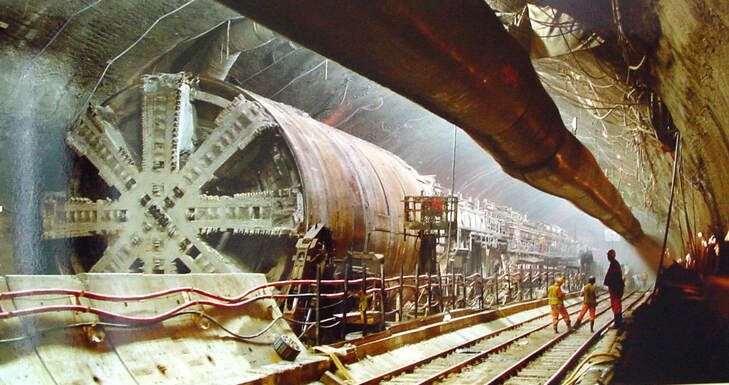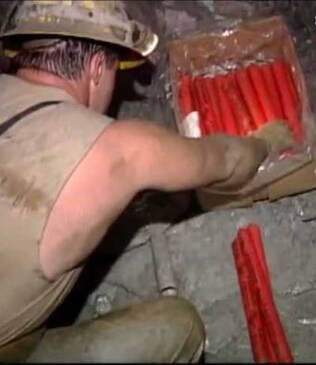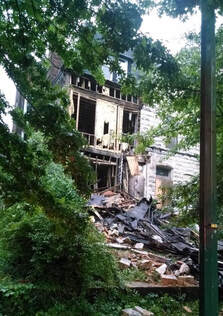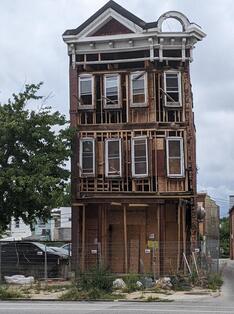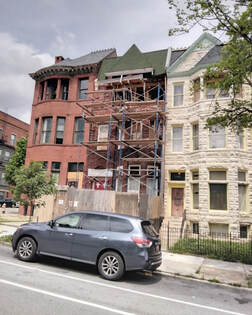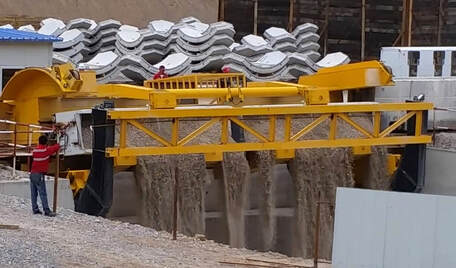ratt's objections to the B&P Tunnel project
Need for a new Environmental Impact Statement (EIS)
Due to flaws in the B&P Tunnel Final Environmental Impact Statement (FEIS) and recent changes, a new EIS is needed for the following reasons:
Claim: "Get to D.C. in 22 (or 30) minutes"
Truth: Acela takes 39 minutes; 2 ½ minute max savings per trip (FEIS VI-80)
Analysis: Tunnels are 2 miles long. At 30 mph it takes 4 minutes to traverse; At 60 mph it takes 2 minutes to traverse.
Train Speed
Claim: “100 (or 110) mph in new tunnel”
Truth: Projected average Acela speed is 67 mph (FEIS III-31); Takes a mile or more to stop a train.
Analysis: It’s less than 4 miles from the MARC station to Penn Station. If the train stops at either station, it
will need to slow down to stop and accelerate when it starts back up.
- MARC would go through an upgraded current B&P tunnel
- Freight would go through Sparrows Point industrial area
B&P: “No increase in freight considered;” “2 freight trains per day”
NEC: “Significant need to increase freight capacity”
Noise and vibration detrimental to citizens of Baltimore
B&P: “Impacts to vibration from train pass-bys not predicted to exceed FTA criteria”
NEC: “Areas of greatest concern are in dense urban areas, including Baltimore;” (NEC FEIS 7.12.2)
“5080 Baltimoreans in noise and vibration zone” (NEC FEIS 7.12-8)
Due to flaws in the B&P Tunnel Final Environmental Impact Statement (FEIS) and recent changes, a new EIS is needed for the following reasons:
- According to the American Bar Association, "Re-evaluation of the EIS is needed if changes are required to the Proposed Action, or if a length of time has passed between FEIS and planned action." Furthermore, a Supplemental EIS should be "prepared if new environmental impacts are discovered, or if the size and scope of the Proposed Action change."
- The November 2016 FEIS is obsolete, being about seven years old.
- Major changes to the project have been announced, to include
- overall project cost
- a phased tunnel deployment approach
- restrictions against diesel and freight trains in Phase 1 tunnels
- use of the existing B&P Tunnel for freight during Phase 1
- size of tunnels and vent buildings
- When the B&P Tunnel Record of Decision was issued, the entire project was estimated at $4.5B. Amtrak claims that the scaled down Phase 1 plan will save $1B, but at the 2021 Juneteenth kickoff, Phase 1 was estimated to cost $4B. Since President Biden's 2023 visit, cost has escalated to $6.02B, a 34% increase! How much will Phase 2 cost? Regardless, this is a lot of taxpayer money to spend to save an estimated 2 1/2 minutes per trip. (FEIS VI-80) Furthermore, an additional major project will be needed to replace the Union Tunnels east of Penn Station, which are also known to be a bottleneck.
- The selected alternative route does not meet the Environmental Criteria specified in the 2014 B&P Tunnel Preliminary Alternatives Screening Report to avoid routes with 1) Residential Land Use, 2) Minority and Low-income Communities, and 3) Historic Districts and Structures.
- Current cost-benefit analysis being promoted in the press is questionable and inconsistent with the original FEIS.
Claim: "Get to D.C. in 22 (or 30) minutes"
Truth: Acela takes 39 minutes; 2 ½ minute max savings per trip (FEIS VI-80)
Analysis: Tunnels are 2 miles long. At 30 mph it takes 4 minutes to traverse; At 60 mph it takes 2 minutes to traverse.
Train Speed
Claim: “100 (or 110) mph in new tunnel”
Truth: Projected average Acela speed is 67 mph (FEIS III-31); Takes a mile or more to stop a train.
Analysis: It’s less than 4 miles from the MARC station to Penn Station. If the train stops at either station, it
will need to slow down to stop and accelerate when it starts back up.
- The FEIS does not consider the impact of more recent rail projects including enhancement of the CSX Howard Street tunnel to accommodate double stack freight and possible development of an east coast Maglev line.
- The comprehensive MTA CAC Proposal to Unravel Baltimore's Tangled Rail Lines was ignored:
- MARC would go through an upgraded current B&P tunnel
- Freight would go through Sparrows Point industrial area
- While the MARC train takes some Baltimorean commuters to D.C., the current Penn Station route does not support commuters who work in downtown Baltimore. (There is a Camden MARC station downtown but it uses CSX’s slow freight line during weekdays and does not operate on game days.)
- The proposed route does not add any new stops to benefit West Baltimore. For example, a new Pennsylvania Avenue stop could connect with the light rail.
- An innovative alternative plan has recently been proposed by AmeriStarRail, which would save 10 minutes per trip, take commuters and tourists downtown, and advance Baltimore's economic development.
- The FEIS does not take into account reduced ridership due to Baltimore's diminishing population and the recent trend to work from home.
- The FEIS study did not examine impacts associated with a realistic increase in freight, the potential for damage to older row houses, or risk to human life from hazmat freight. Freight rail companies were not participants in the study.
- The B&P Tunnel is part of the larger Amtrak Northeast Corridor (NEC) project; however, the B&P FEIS and NEC FEIS are inconsistent:
B&P: “No increase in freight considered;” “2 freight trains per day”
NEC: “Significant need to increase freight capacity”
Noise and vibration detrimental to citizens of Baltimore
B&P: “Impacts to vibration from train pass-bys not predicted to exceed FTA criteria”
NEC: “Areas of greatest concern are in dense urban areas, including Baltimore;” (NEC FEIS 7.12.2)
“5080 Baltimoreans in noise and vibration zone” (NEC FEIS 7.12-8)
|
Environmental Justice (EJ)
|
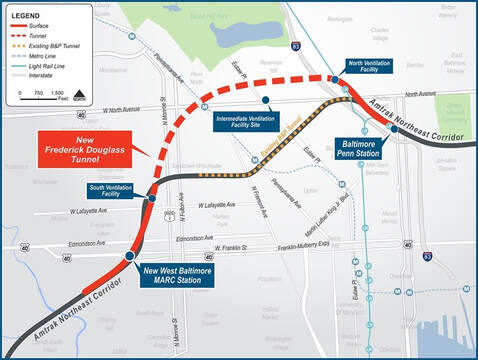
"An EJ population is defined to include any Census Block Group in which the minority or low-income population meets either of the following thresholds: a) The minority or low-income population exceeds 50 percent, or b) The percentage of minority or low-income population in the affected area is “meaningfully greater” than the percentage of minority or low-income population in the general population." (FEIS VI-5)
|
Danger to Human Life
- The use of Tunnel Boring Machines (TBMs) and explosives under densely populated residential neighborhoods and businesses during construction of the tunnels could be catastrophic. The government has not investigated the risks of tunnel collapse during drilling and possible harm that could result.
- The two Phase 1 tunnels will go directly under 275 properties, mostly homes. Phase 2 construction will endanger hundreds of additional homes.
- The transport of hazardous freight during Phase 2 operation of the tunnels has not been evaluated.
- The risk of terrorist acts on passenger trains within the tunnels has not been considered.
Architectural Damage - Need for an Architectural/Structural/Geotechnical Engineering Study
- It was originally announced that 22 houses, 13 businesses, and 4 churches will be acquired and demolished. (FEIS VI-20, VI-37 and Appendix A) More recently (9/2023 NEPA Re-Evaluation #2) it was announced that an additional 23 properties will be acquired by Amtrak.
- Four large historic districts (three are listed in the National Register of Historic Places) and other historic properties will be impacted: Reservoir Hill Historic District, Edmondson Avenue Historic District, Midtown-Edmondson Historic District, and Greater Rosemont Historic District.
- According to the FEIS, the selected route would have an adverse impact on historic properties. The Maryland Historic Trust and other historic building consultants have raised concerns about vibration damage in Reservoir Hill, the size and location of the central vent building, adverse visual effects in Midtown Edmondson, and impacts to Edmonson Avenue historic properties. (FEIS VI-52)
- Baltimore’s charming old rows and many historic structures are made of unframed brick with soft mortar. These fragile structures are easily damaged by vibration – even passing buses cause cracks and fallen plaster.
- Historic rowhouses cannot withstand the massive Tunnel Boring Machines, underground explosives, construction trucks, and up to 388 trains PER DAY without significant damage.
- Modern homes are constructed to withstand several inches of movement. 19th century brick rowhouses were not. According to the FEIS, damage to modern homes can occur at a vibration level of 2 inches per second. For older homes, damage is likely to occur at .5 inches per second. (FEIS VI-131)
- According to the FEIS, "The evaluation of blast-induced vibrations for shaft construction is complex and is anticipated to have the most impact to the public." It may range up to .4 inches per second, not far from the .5 inches per second damage threshold for older buildings. (FEIS VI-133)
- Some buildings in the tunnel construction area are already in highly compromised condition due to age, neglect, vacancy, restoration, storms, earthquakes, City infrastructure maintenance, road traffic, and other causes.
- Historically there has been much damage to houses, buildings, and streets due to TBM boring. This process, which involves water, can cause sinkholes, collapses, settling, and cracking of buildings. TBM collapses have been responsible for loss of life.
- The current plan has a token funding provision with no guarantees for repairing home structural damage that occurs during the construction phases of the project.
- Some homeowners insurance policies do not cover damage from underground sources. Furthermore, most insurance policies would not cover full rebuild costs in case of a building collapse.
- Structural damage caused by tunnel construction may not be readily apparent. Documenting and proving that damage was caused by the tunnels could be difficult and expensive for the property owner.
- According to the B&P Tunnel Vibration Technical Report, there is a great deal of uncertainly regarding the impact of TBM vibration on our particular homes in their geological setting. (Vibration Tech Report 14 X.A.)
- We, as citizens, deserve a full architectural/structural and geotechnical engineering study of this specific project, these specific houses, and ground conditions under our neighborhoods to determine whether the risk to our homes (and lives) justifies the project.
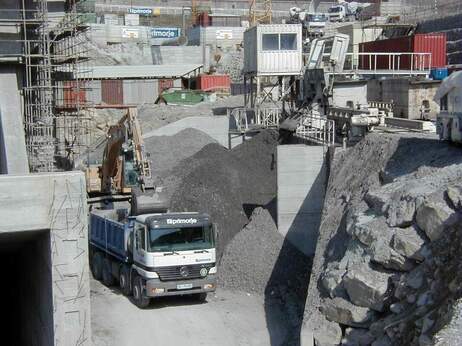 Truck removing soil and rock debris extracted by a Tunnel Boring Machine
Truck removing soil and rock debris extracted by a Tunnel Boring Machine
Years of Heavy Construction
- West Baltimore neighborhoods are faced with 10-15 years of heavy construction (2022 NEPA Reevaluation p. 8 2. B.) and thousands of heavy truck runs to remove 47 million cubic feet of rock and soil (NEPA Reevaluation p. 16 F). Neighborhoods have already suffered through several massive improvement projects that have filled our streets, houses, and cars with dust. Power and water outages are likely to occur. Traffic patterns and road surface quality will be disrupted for years.
- According to the B&P Tunnel Vibration Technical Report, "Heavy machinery, the major source of vibration in construction, is constantly moving in unpredictable patterns... Project construction activities could include tunnel excavation, relocating utilities and track laying. These excavation activities typically include tunnel boring machines (TBM), earth-moving equipment, and heavy-duty impulsive equipment, such as pile drivers..."
- Tunnel boring and construction will occur in proximity to elementary schools.
- There will be "staging areas" (several acres in size) where debris removal will be focused at each B&P Tunnel portal and vent site. "Slurry pits" or "muck tanks" will be established to store rubble removed from the tunnels.
- Temporary noise barriers, power plants (diesel?), and a concrete plant will also be operational at the staging areas throughout the project.
- The construction will disrupt multimillion dollar initiatives to improve North Avenue.
- Amtrak lacks experience constructing a tunnel project of this size and scope, and has a history of delays and cost overrun.
No safeguards against future damage
- There are NO funds set aside for damages due to settling post-construction, vibration during operation of the tunnels, or underground explosions due to hazardous freight derailment.
Pollution from Diesel Fumes
- Amtrak is touting their electric trains, but not mentioning diesel fumes from freight trains that will potentially use the current B&P Tunnel (Phase 1) and new tunnels 3 and 4 (Phase 2).
- Following Phase 2, unfiltered diesel fumes will be concentrated near the vent buildings, but will spread city-wide through residential neighborhoods and business areas.
- Baltimore already has a significantly higher rate of asthma than the rest of Maryland. Expect more ‘code orange’ days, asthma, and breathing problems.
- People who live near the rails are well aware of the black diesel pitch build-up on their windows and sills.
|
Huge Vent Buildings
|
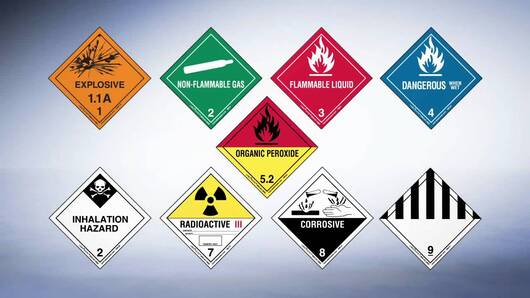 The 9 Hazmat Categories
The 9 Hazmat Categories
Hazardous Freight
- The 2 tunnels developed in Phase 2 will open a new double-stacked and hazardous freight route right through the city, while other cities are shutting these down!
- CSX currently transports hazardous materials (Hazmat) through the Howard Street Tunnel. The new B&P Tunnels will provide a new route for Norfolk Southern and CSX to transport more hazardous freight under and through additional neighborhoods.
- Hazmat is usually transported in tank cars.
- The 2001 Howard Street derailment sparked a chemical fire that raged for five or six days and shut down the downtown area.
- More recently Baltimore has been extremely lucky with the nature of its freight rail ‘accidents’, with derailed cars being empty and gas cars not leaking after collisions. But counting on luck is a bad plan.
|
Noise and Vibration
|
|
Amtrak Counts on Citizen Ignorance
Amtrak is busy selling the passenger rail improvements in this “all or nothing” pitch. But this plan is more than double what Amtrak needs for its own operations. Were you aware of the huge freight aspect of this plan? If asked, would you vote “yes” to open a swath for massive, polluting double-stacked freight trains through the city?
Amtrak is busy selling the passenger rail improvements in this “all or nothing” pitch. But this plan is more than double what Amtrak needs for its own operations. Were you aware of the huge freight aspect of this plan? If asked, would you vote “yes” to open a swath for massive, polluting double-stacked freight trains through the city?
Eminent Domain
Amtrak will use eminent domain to circumvent our rights as property owners to dig under our homes and, in some cases, to demolish homes and businesses. We don’t want eminent domain improperly used to take away our rights and benefit railroads while harming our communities.
Amtrak will use eminent domain to circumvent our rights as property owners to dig under our homes and, in some cases, to demolish homes and businesses. We don’t want eminent domain improperly used to take away our rights and benefit railroads while harming our communities.
Baltimore's neighborhoods have suffered from the negative impacts of transportation projects in the past that were not for our benefit. We have come together to acknowledge the previous environmental injustices against West Baltimore and take a stand against this new threat.


